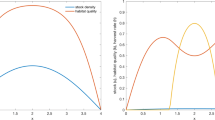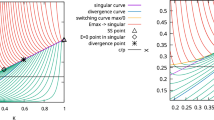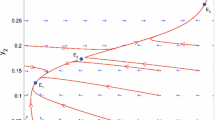Abstract
Renewable resources such as fish exist within habitats. Harvesting activities may directly impact the habitat, beyond the influence caused by changing the balance between species. When harvesting activities impact stock size and habitat health in different ways, both states must be explicitly considered. A classic fisheries model is embedded in a habitat that exhibits shallow lake dynamics, where carrying capacity depends on habitat health and fishing effort damages the habitat. Hysteresis in the habitat dynamics can manifest itself as multiple steady states for both the dynamic and open access solutions. Numerical explorations of the model suggest that a new fishery in such a setting should often be managed to protect the health of the habitat, while it may not be optimal to restore a fishery in an already degraded habitat. Conventional policy tools applied in their classic form are unlikely to be effective.
Similar content being viewed by others
References
Anderies JM, Janssen MA, Walker BH (2002) Grazing management, resilience, and the dynamics of a fire-driven rangeland system. Ecosystems 5(1): 23–44
Armstrong CW (2006) A note on the ecological–economic modelling of marine reserves in fisheries. Ecol Econ 62(2): 242–250
Atolia M, Buffie EF (2007) Reverse shooting made easy: automating the search for the global nonlinear saddle path, August
Barbier EB (2000) Valuing the environment as input: review of applications to mangrove-fishery linkages. Ecol Econ 35: 47–61
Barbier EB (2003) Habitat-fishery linkages and mangrove loss in Thailand. Contempor Econ Policy 21(1): 59–77
Barbier EB, Strand I (1998) Valuing mangrove-fishery linkages: a case study of Campeche, Mexico. Environ Resour Econ 12: 151–166
Batabyal AA (2002) Human actions, the survival of keystone species, and the resilience of ecological-economic systems. Resour Policy 28: 153–157
Bjorndal T, Conrad JM (1987) The dynamics of an open access fishery. Can J Econ 20(1): 74–85
Botsford LW, Castilla JC, Peterson CH (1997) The management of fisheries and marine ecosystems. Science 277: 509–515
Brock WA, De Zeeuw A (2002) The repeated lake game. Econ Lett 76: 109–114
Brock WA, Starrett D (2003) Managing systems with non-convex positive feedback. Environ Resour Econ 26: 575–602
Carpenter SR, Ludwig WA, Brock D (1999) Management of eutropication for lakes subjects to potentially irreversible change. Ecol Appl 9: 751–771
Christensen V, Pauly D (1998) Changes in models of aquatic ecosystems approaching carrying capacity. Ecol Appl 1: S104–S109
Clark C (1976) Mathematical bioeconomics. Wiley, New York
Collie JS, Hall SJ, Kaiser MJ, Poiner IR (2000) A quantitative analysis of fishing impacts on shelf-sea benthos. J Anim Ecol 69: 785–798
Crépin A-S (2007) Using fast and slow processes to manage resources with thresholds. Environ Resour Econ 36: 191–213
Eaton JW, Bateman D, Hauberg S (2008) GNU octave manual version 3. Network Theory Limited, Bristol
Finnoff D, Tschirhart J (2003) Harvesting in an eight-species ecosystem. J Environ Econ Manage 45(3): 589–611
Folke C, Carpenter S, Walker B, Scheffer M, Elmqvist T, Gunderson L, Holling CS (2004) Regime shifts, resilience, and biodiversity in ecosystem management. Annu Rev Ecol Evol Syst 35: 557–581. doi:10.1146/annurev.ecolsys.35.021103.105711
Guttormsen AG, Kristofersson D, Naevdal E (2008) Optimal management of renewable resources with darwinian selection induced by harvesting. J Environ Econ Manage 56: 167–179
Hare SR, Mantua NJ (2000) Empirical evidence for North Pacific regime shifts in 1977 and 1989. Progress Oceanogr 47: 103–145
Holland D, Schnier KE (2006) Individual habitat quotas for fisheries. J Environ Econ Manage 51: 72–92
Hopfenberg R (2003) Human carrying capacity is determined by food availability. Popul Environ 25(2): 109–117
Janssen MA, Anderies JM, Walker BH (2004) Robust strategies for managing rangelands with multiple stable attractors. J Environ Econ Manage 47: 140–162
Knowler D, Barbier EB, Strand I (2002) An open-access model of fisheries and nutrient enrichment in the Black Sea. Mar Resour Econ 16: 195–217
Kramer DB (2008) Adaptive harvesting in a multiple-species coral-reef food web. Ecol Soc 13(1): 17
Lindholm PJ, Auster JB, Ruth M, Kaufman L (2001) Modeling the effects of fishing and implications for the design of marine protected areas: juvenile fish repsonses to variations in seafloor habitat. Conserv Biol 15: 424–437
Meyer PS, Ausubel JH (1999) Carrying capacity: a model with logistically varying limits. Technol Forecast Social Change 61(3): 209–214
Mäler KG, Xepadadeas A, De Zeeuw A (2003) The economics of shallow lakes. Environ Resour Econ 26: 603–624
Muradian R (2001) Ecological thresholds: a survey. Ecol Econ 38: 7–24
Odum EP (1969) The strategy of ecosystem development. Science 164(3877): 262
R Development Core Team R (2008) a Language and Environment for Statistical Computing. R Foundation for Statistical Computing, Vienna, Austria, 2008. URL:http://www.R-project.org. ISBN 3-900051-07-0
Rosser BJ Jr. (2001) Complex ecological–economic dynamics and environmental policy. Ecol Econ 37: 23–37
Sanchirico JN, Wilen JE (2001) Dynamics of spatial exploitation: a metapopulation approach. Nat Resour Model 14(3): 391–418
Scheffer M, Brock W, Westely F (2000) Socioeconomic mechanisms preventing optimum use of ecosystem services: an interdisciplinary theoretical analysis. Ecosystems 3: 451–471
Scheffer M, Carpenter S, Foley JA, Folke C, Walker B (1997) Catastropich shifts in ecosystems. Nature 413: 591–596
Scheffer M (2004) Ecology of shallow lakes. Kluwer, Dordrecht
Skiba AK (1978) Optimal growth with a convex-concave production function. Econometrica 46(3): 527–539
Sterner T (2007) Unobserved diversity, depletion and irreversibility: the importance of subpopulations for management of cod stocks. Ecol Econ 61: 566–574
Ströbele WJ, Wacker H (1995) The economics of harvesting predator-prey systems. J Econ 61: 65–81
Sumaila UR, Guénette S, Alder J, Chuenpagdee R (2000) Addressing ecosystem effects of fishing using marine protected areas. ICES J Mar Sci 57: 752–760
Wacker H (1999) Optimal harvesting of mutualistic ecological systems. Resour Energy Econ 21: 89–102
Wagener FOO (2003) Skiba points and heteroclinic bifurcations, with applications to the shallow lake system. J Econ Dyn Control 27: 1533–1561
Willemsen J (1980) Fishery-aspects of eutrophication. Aquat Ecol 14(1): 12–21
Wirl F (2004) Thresholds in concave renewable resource models. Ecol Econ 48: 259–267
Zeeman, EC (ed) (1977) Catastrophe theory: selected papers, 1972–1977. Addison-Wesley, Reading
Author information
Authors and Affiliations
Corresponding author
Rights and permissions
About this article
Cite this article
Janmaat, J.A. Fishing in a Shallow Lake: Exploring a Classic Fishery Model in a Habitat with Shallow Lake Dynamics. Environ Resource Econ 51, 215–239 (2012). https://doi.org/10.1007/s10640-011-9495-5
Accepted:
Published:
Issue Date:
DOI: https://doi.org/10.1007/s10640-011-9495-5




